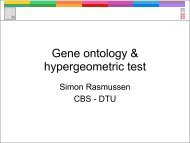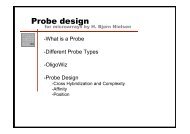Computational tools and Interoperability in Comparative ... - CBS
Computational tools and Interoperability in Comparative ... - CBS
Computational tools and Interoperability in Comparative ... - CBS
You also want an ePaper? Increase the reach of your titles
YUMPU automatically turns print PDFs into web optimized ePapers that Google loves.
Fig. 2 Genes (or segments) from each genome are compared with a reference gene, as shown <strong>in</strong><br />
the left panel; a pairwise comparison is made us<strong>in</strong>g one of the BLAST algorithms. On the right is<br />
shown the ‘‘remapp<strong>in</strong>g’’, or the representation of each of the BLAST runs on the left, mapped<br />
onto the chromosomal sequence. Note that gaps <strong>in</strong> the reference gene (grey) are not <strong>in</strong>cluded <strong>in</strong><br />
the colored maps of the atlas.<br />
genome <strong>and</strong> custom data <strong>and</strong> DNA<br />
properties are collected, an XML configuration<br />
file is composed which conta<strong>in</strong>s<br />
all these data <strong>and</strong> the layout of the atlas.<br />
This file is then sent to the GeneWiz 7<br />
software which produces a PostScript<br />
document, it then is base64 encoded to<br />
allow transport via XML. This part of<br />
the process takes place on the server <strong>and</strong><br />
requires no user-<strong>in</strong>teraction. An example<br />
atlas of a plasmid is shown <strong>in</strong> Fig. 3, <strong>and</strong><br />
will be discussed <strong>in</strong> more detail below.<br />
Web services implementation<br />
A WSDL (web services description language)<br />
file is written which describes the<br />
operations (runAtlas, pollQueue, fetch-<br />
AtlasResult) <strong>and</strong> the <strong>in</strong>put requirements<br />
for them. The file can be downloaded.<br />
All <strong>in</strong>put/output objects are def<strong>in</strong>ed <strong>in</strong> a<br />
separated XSD file (XML schema def<strong>in</strong>ition)<br />
with<strong>in</strong> the WSDL file, which comprises<br />
<strong>in</strong>formation <strong>and</strong> type restrictions<br />
applicable <strong>in</strong> the request. This serves as<br />
documentation of the objects as well as a<br />
way to validate a request before it is<br />
submitted. Unfortunately, the validation<br />
supports only Perl modules for now that<br />
is not optimal yet, whereas this option is<br />
well implemented <strong>in</strong> <strong>tools</strong> like soapUI<br />
(http://www.soapui.org/). It should be<br />
stressed that users should, until better<br />
validation support can be implemented,<br />
be careful to correctly format the <strong>in</strong>put<br />
parameters before send<strong>in</strong>g the request.<br />
Fig. 3 BLASTatlas of pE88—a small plasmid of Clostridium tetani stra<strong>in</strong> E88, GenBank accession number AF528097. DNA parameters percent AT,<br />
GC skew, global direct repeats, <strong>and</strong> global <strong>in</strong>verted repeats are <strong>in</strong>cluded <strong>in</strong> the <strong>in</strong>ner most lanes. BLAST lanes of all complete genome sequences of the<br />
Clostridium genomes (see Table 1), <strong>in</strong>clud<strong>in</strong>g plasmids are <strong>in</strong>cluded <strong>in</strong> the outer most lanes. As examples of custom lanes, the free energy (G, blue kcal<br />
mol 1 ) <strong>and</strong> the probability (P, red) measures of stress <strong>in</strong>duced DNA duplex destabilization (SIDD) sites are <strong>in</strong>cluded <strong>in</strong> the lanes between the DNA<br />
properties <strong>and</strong> the BLAST lanes. 23 SIDD calculations were obta<strong>in</strong>ed from the SIDDbase WebService (http://www.cbs.dtu.dk/ws/SIDDbase). The<br />
request XML used to construct this plot can be downloaded from the example section of the service homepage, http://www.cbs.dtu.dk/ws/BLASTatlas.<br />
As expected, there is full homology of all cod<strong>in</strong>g regions between the plasmids <strong>and</strong> all replicons of C. tetani E88 (black lane just outside of the<br />
annotations); however there appears to be limited conservation of these pE88 genes throughout the genomes for other Clostridium stra<strong>in</strong>s.<br />
366 | Mol. BioSyst., 2008, 4, 363–371 This journal is c The Royal Society of Chemistry 2008









